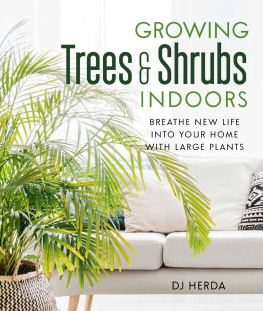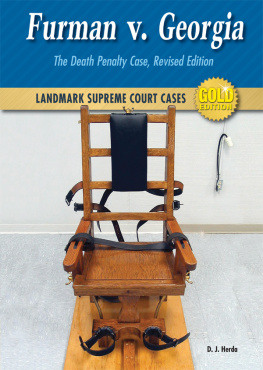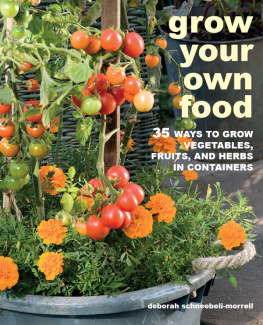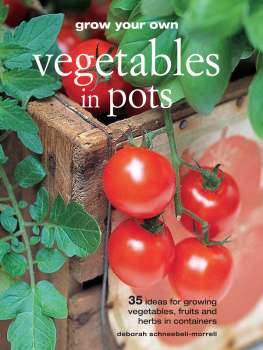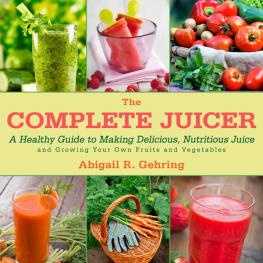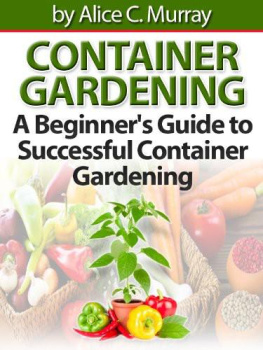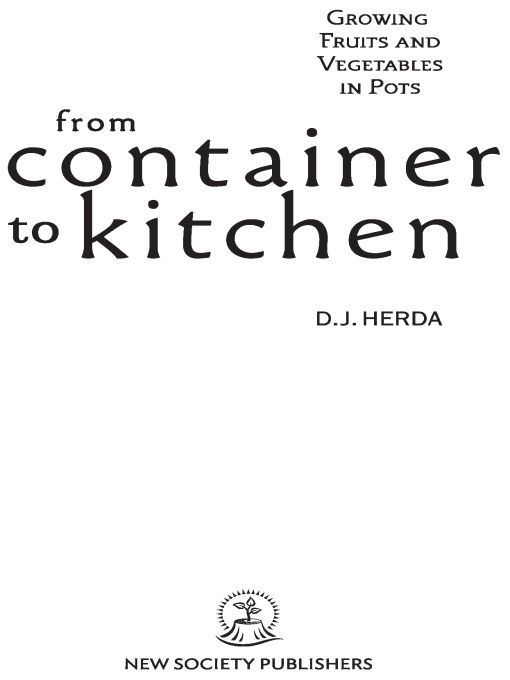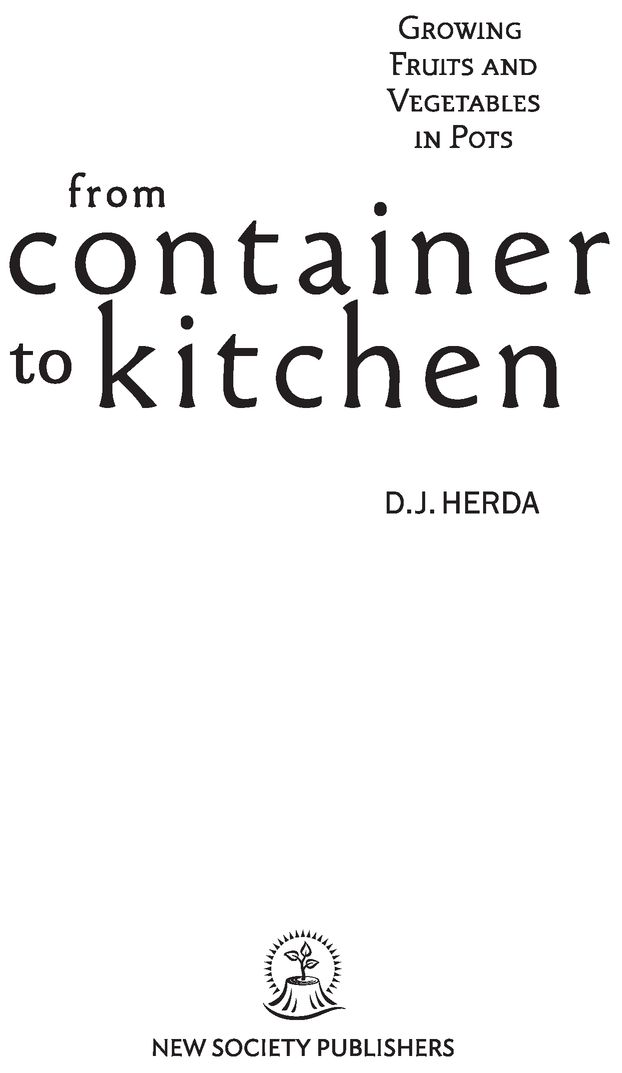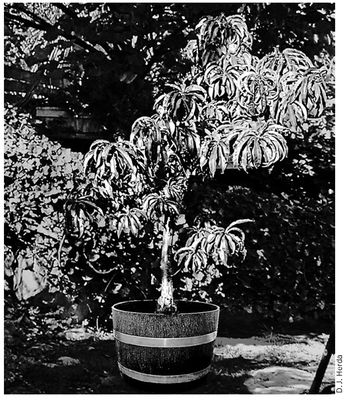Table of Contents
Advance Praise for From Container to Kitchen
I have been reading the gardening books of master grower D. J. Herda for more than twenty years. His latest From Container to Kitchen is very likely his best. It goes to show that anyone who wants a garden can have a garden, no matter where he or she lives! Its an invaluable guide filled with fun facts and useful tips. Pick up a copy as soon as you can. You wont regret it.
DON BACUE, former executive editor,
International Features Syndicate
With From Container to Kitchen, D. J. Herda shows us not only the importance of eating healthy and saving money, but the joy and peace to be found in creating sustainability. This book is among the best Ive read on the actual importance of getting back to nature, no matter where you live.
MICHIELLE DJ BECK, Author, Content Creator, Editor (www.michiellebeck.com)
From Container to Kitchen is a refreshing twist on the how-to approach, combining practical information along with DJs personal experience with and love for container gardening. If youre not a container gardener now, you will be after you read this book!
ANNETTE RANALD, author and attorney.
Introduction
The first book I ever published on the subject of growing plants in containers was one of the first books I ever published period. It was called Growing Trees Indoors, and it was a runaway hit, coming within a few hundred thousand copies of making the New York Times Bestsellers List.
The book earned me, back in 1979, nearly universal praise (someone from Wisconsins Mt. Horeb Mail said it was a damned fine book, with pictures and everything) and garnered me a fortune in royalties, totaling nearly $800, if memory serves me correctly. It also taught me a valuable lesson about the concept of growing plants in containers: People werent ready for it.
Today, more than 30 years later, all that has changed. For one thing, Im just about exactly 30 years older. For another, Im a whole lot smarter. And, finally, people are ready for it.
Why the change in attitude? Why is today the right time for a book on growing plants in containers and not only plants, but edible plants, fruits of the womb, sustainable-growth harvestable manna as opposed to a book on container gardening more than three decades ago?
Filling a Void
Well, for starters, more people than ever before are living in urban environments. Apartments, condominiums, spider holes stacked neatly one on top of another just about any habitable space is being inhabited. That means that more people than ever before are no longer able to enjoy the benefits of traditional gardening. Its difficult to walk out the back door, grab a shovel and begin rooting around in the yard when the yard consists of three cubic feet of poured concrete separating the high rise apartment building next door from the one in which you live.
The fact that most people dont have access to large yards or corner lots or sprawling acres in the countryside anymore doesnt negate their innate desire to garden, of course. It only makes their desire to garden that much stronger. The gardening urge is genetically implanted in our souls. Gardening is as old an activity as modern mankind. Before ancient hunters came gardeners. Before ancient real-estate brokers came gardeners. Before even Rupert Murdoch came gardeners. In fact, the only human activity to precede gardening was gathering. Gatherers wandered from area to area, scrounging up enough fruits and berries, seeds and nuts to sustain them throughout their lifetime, which must have averaged fifteen or twenty years. And many of them were gatherers only because they hadnt yet discovered Burpees online catalog!
Today, people feel a need to get back to their prehistoric origins, to return to their genetically programmed basics something that is difficult to do when you live in New York or Chicago or Los Angeles, damned near impossible to do when you live in a three-story brownstone or a high-rise megalith spiraling hundreds of feet above Lake Michigan.
A Healthier Alternative
People also feel a need to garden because theyre more health-conscious than their ancestors were. Theyre better informed about the world around us. With all of the periodic stories about tainted fruits and vegetables including salmonella, which, contrary to popular belief, does not come exclusively from salmon who wouldnt worry? With all the tales about produce laced with toxins and heavy metals, about irradiated and otherwise diminished foodstuffs of questionable nutritional value and similar concerns, its suddenly not only socially expedient but also physiologically critical to find a source of clean, fresh, vitamin-rich produce. At least it is for anyone who doesnt consider Fruit Loops and Bloomin Onions to be among the US Department of Healths top two food groups.
Yet today when you visit the produce section of your local supermarket, you find apples that were picked in Madagascar three weeks ago; tomatoes that were plucked green, gassed and trucked up from Mexico four weeks ago; bananas that were picked unripened from a plantation in Costa Rica five weeks ago; and bell peppers whose origins and date of harvest are still a mystery.
Stand back and watch as little kids fondle the produce right after holding their pet frogs and iguanas. You see adults coughing and sneezing into their hands before hefting a dozen tomatoes and returning them to the stand as not quite suitable. You observe employees hoisting cardboard boxes from stacks of other cardboard boxes sitting on the floor and emptying their contents into bins marked Special $2.79 a Pound.
Fresh, healthful fruit and produce? You tell me.
Cutting Costs
People are also turning increasingly to gardening because they worry about the high cost of shopping. I remember a time not long ago when meat was the most expensive thing you could buy at your local supermarket and vegetarians were considered frugal, if not outright weird. Today, fresh fruits and vegetables rival, and in many cases surpass, the cost of meat thanks in great part to spiraling harvest and delivery costs and vegetarians present a glowing portrait of people who know something the rest of us dont. Of course, theyre still considered weird, but thats another story.
With the rising cost of produce such as we are experiencing, how can we cope? Who wants to take out a second mortgage on the condo merely to buy fresh fruits and vegetables? Who wants to give up financial liquidity for a few more years of physical and emotional well-being? Or could there be another way?
This dwarf nectarine tree adapts nicely to container growth and bears full-sized fruit every summer
The Time Is Now
Finally, I felt the time was right for a book on growing plants in containers because I need the money. Had that original tome about growing trees indoors that I wrote lo! those many years ago sold better, I probably wouldnt have had to write another book on container gardening ever.
But that was not the case. I abhor refined sugars and starches; I hate paying through the nose for things that I could be supplying for myself and my family for next to no cost; and I want to put all of the knowledge I have gained about container gardening to good use. What choice did I have but to tackle the ultimate book on fruit and vegetable gardening?


